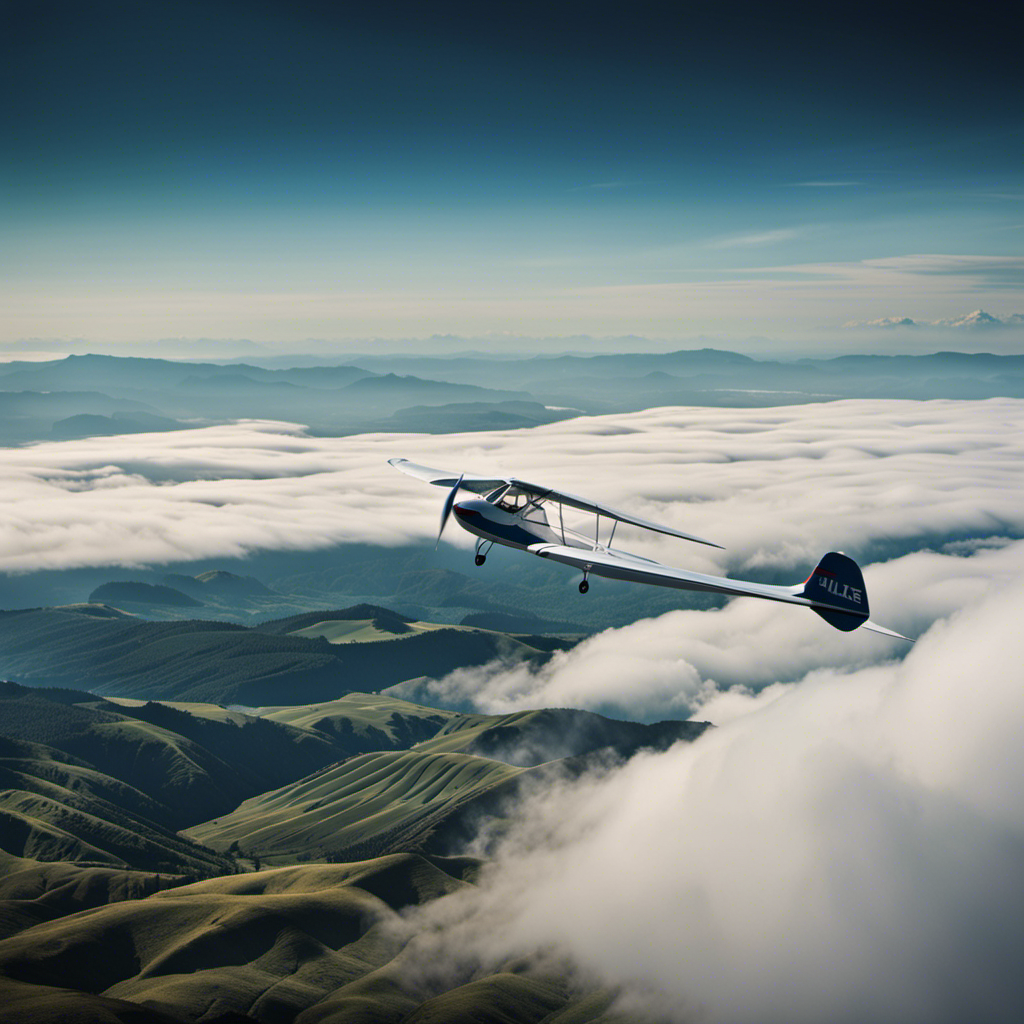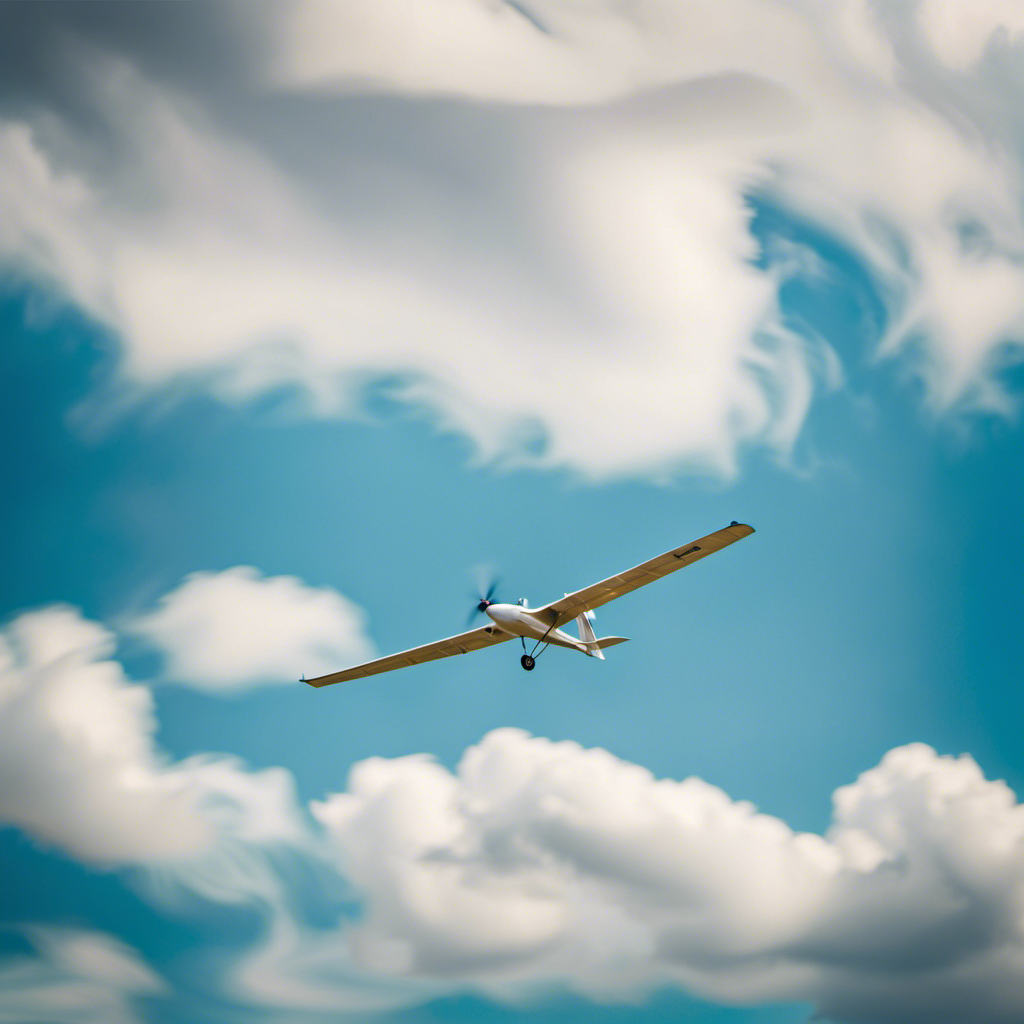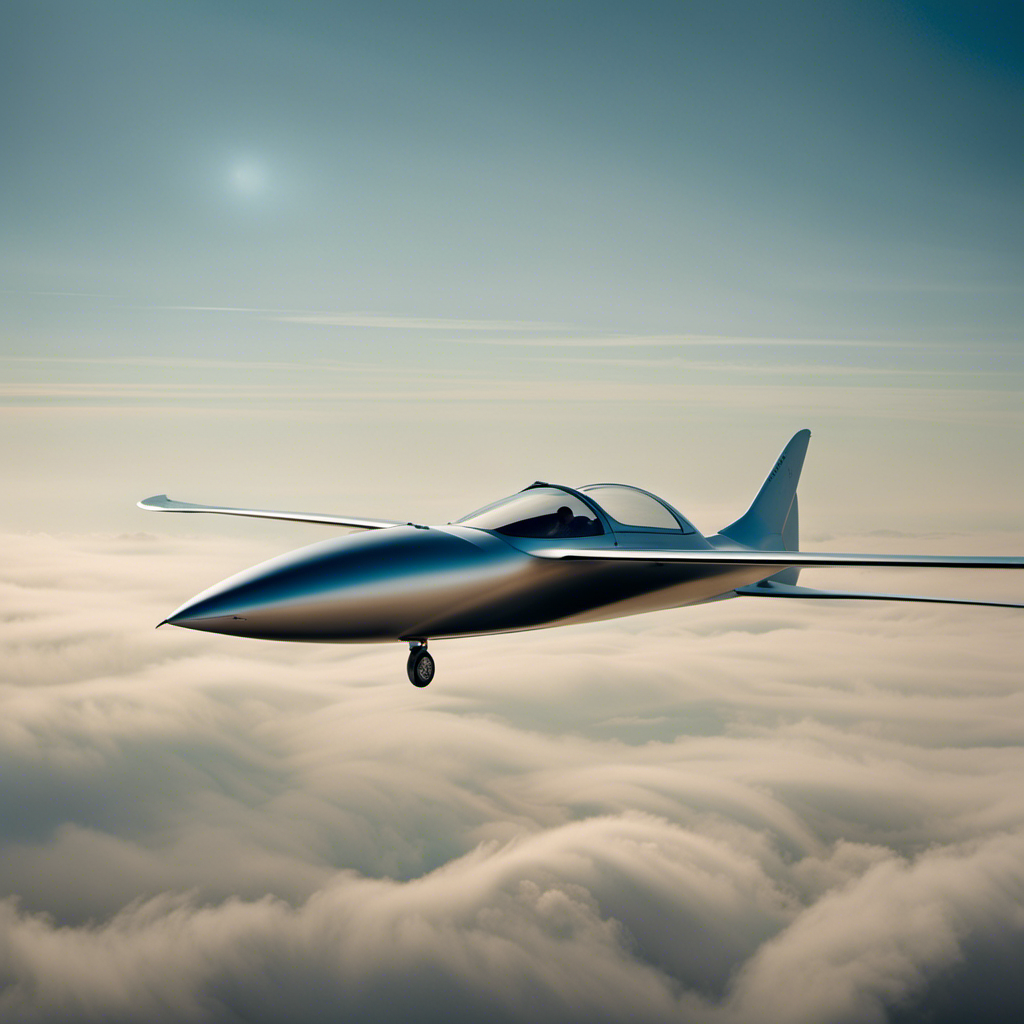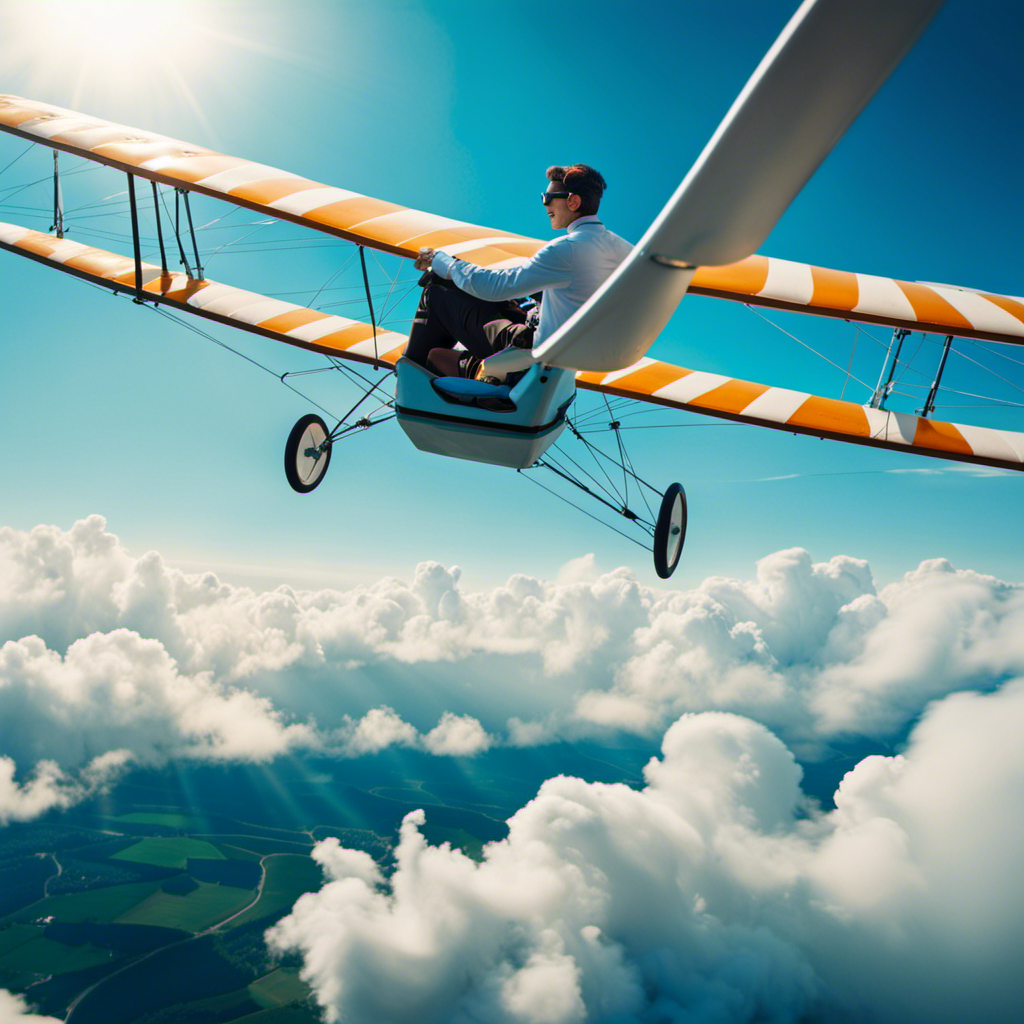While soaring through the endless sky, I was overcome with a deep sense of freedom and exhilaration.
Cross-country gliding has always been my passion, allowing me to explore new horizons and experience the world from a unique perspective.
With careful planning, precise navigation, and a supportive gliding community, I’ve embarked on countless adventures, overcoming challenges and marveling at breathtaking aerial views.
Join me as I take you on a journey through the joys and rewards of cross-country gliding.
Key Takeaways
- Weather conditions greatly impact the performance of a glider in cross-country gliding.
- Effective route planning and navigation are essential for a successful cross-country gliding adventure.
- Techniques for gaining altitude, such as utilizing thermals and ridge lift, are crucial for gliding across long distances.
- Safety measures, emergency preparedness, and being part of a supportive gliding community contribute to a fulfilling gliding experience.
The Basics of Cross-Country Gliding
Cross-country gliding involves navigating long distances using a glider aircraft. As a glider pilot, I rely on careful planning strategies and knowledge of weather conditions to ensure a successful flight. One of the key aspects of planning a cross-country gliding adventure is assessing the weather conditions. I closely monitor weather forecasts and pay attention to factors such as wind direction, speed, and thermal activity. These factors greatly influence the performance and efficiency of the glider. By understanding the weather patterns, I can make informed decisions about the best time to launch and the optimal route to take.
In addition to studying weather conditions, I also consider other planning strategies. I analyze the terrain and topography of the area, looking for features such as ridges or valleys that can create lift or sink. I plan my route accordingly, aiming to maximize lift and minimize sink. It’s important to have alternative landing locations in mind, in case unexpected circumstances arise during the flight. I also take into account the distance I can comfortably cover based on the glider’s range and my own endurance.
With a thorough understanding of weather conditions and effective planning strategies, I can confidently embark on a cross-country gliding adventure. In the next section, I will discuss the importance of planning your route, which plays a crucial role in the success of the journey.
Planning Your Route
To plan your route effectively, you’ll want to consult weather reports and navigation charts. Route optimization is crucial in cross-country gliding to ensure a smooth and efficient journey. Before taking off, I always check the weather conditions to determine the wind direction and speed. This information helps me decide the best route to take, as I can take advantage of tailwinds to gain speed and conserve energy. I also consider other weather considerations such as cloud cover and thermals.
Thermals are columns of warm air that can provide lift and help me gain altitude. By analyzing weather reports, I can identify areas with strong thermals and plan my route accordingly.
In addition to weather reports, navigation charts are invaluable tools for planning my route. These charts provide information about airspace restrictions, landmarks, and topography, which helps me navigate through unfamiliar terrain. I carefully study these charts and identify waypoints along my intended route, allowing me to stay on track and avoid obstacles.
Once I have planned my route, the next step is taking off and gaining altitude.
Taking Off and Gaining Altitude
After checking the weather conditions, I’ll begin my gliding adventure by taking off and gaining altitude. The thrill of soaring through the sky is unmatched, and mastering the art of staying aloft is crucial to a successful cross-country journey. Here are four techniques that I employ to maximize my altitude and extend my flight time:
-
Centering thermals: Thermals are columns of rising air that glider pilots rely on to gain altitude. By carefully circling within a thermal, I can stay within its core and climb higher.
-
Using ridge lift: When wind hits an obstacle like a hill or mountain, it is forced upward, creating ridge lift. By flying close to these formations, I can take advantage of the updrafts and gain altitude.
-
Riding wave lift: In certain weather conditions, atmospheric waves form at high altitudes. By carefully navigating these invisible waves, I can harness their energy and gain significant altitude.
-
Employing speed-to-fly techniques: By adjusting my speed based on the conditions, I can optimize my glide ratio and maintain altitude more efficiently.
By mastering these soaring techniques and maximizing thermals, I can stay aloft for extended periods, covering great distances without the need for an engine.
In the next section, I will discuss the art of navigating across distances without relying on traditional navigation methods.
Navigating Across Distances
When it comes to navigating across distances, there are several key points to consider.
First, using GPS and navigation instruments is crucial in ensuring accurate and efficient navigation. These tools provide real-time information on my location, altitude, and direction, helping me stay on track during my cross-country adventures.
Second, reading the landscape is an important skill that allows me to identify natural landmarks and geographic features, which serve as reference points during my flights.
Lastly, being able to identify man-made landmarks, such as towns, roads, and buildings, further enhances my navigation abilities and helps me stay oriented during long flights.
Using GPS and Navigation Instruments
Now that we’re equipped with GPS and navigation instruments, finding our way during cross-country glider adventures has become much easier. Using GPS for precision navigation has revolutionized the way we navigate through the skies. With satellite technology at our fingertips, we can accurately determine our position, track our progress, and plan our routes with utmost precision.
This becomes especially crucial when navigating in challenging weather conditions. When faced with strong winds, turbulence, or low visibility, our GPS helps us stay on course and avoid potential hazards. However, relying solely on technology would be unwise.
As glider pilots, we also rely on reading the landscape and identifying landmarks to supplement our GPS navigation. By observing natural features, such as rivers, roads, and mountains, we can confirm our position and make informed decisions about our flight path.
Reading the Landscape and Identifying Landmarks
By observing the landscape and identifying landmarks, we can confirm our position and make informed decisions about our flight path. Reading the landscape is a skill every glider pilot must develop.
From high above, I scan the terrain below, looking for distinct features that can help me navigate. Rivers winding their way through the countryside, mountain ranges stretching towards the horizon, or even man-made structures like bridges and buildings serve as valuable landmarks.
These visual cues not only help me determine my location but also provide valuable information about wind patterns and potential thermals. As I glide through the air, admiring the aerial views, the landscape below becomes a tapestry of beauty, inviting me to explore and discover the world from a unique perspective.
Admiring the Aerial Views
When it comes to exploring the world from above, there are three key points that make the experience truly awe-inspiring.
First, the opportunity to witness spectacular landscapes and natural wonders from a bird’s-eye perspective is unparalleled. From towering mountains to winding rivers and lush forests, the view from above offers a whole new level of appreciation for the beauty of our planet.
Second, wildlife spotting becomes an exhilarating adventure as you soar through the sky. Spotting majestic creatures in their natural habitat, such as whales breaching or herds of elephants roaming, is a sight that will stay with you forever.
Lastly, the bird’s-eye perspective itself is a unique and thrilling experience that allows you to see the world in a completely different way. The sense of freedom and the adrenaline rush of being up in the air, gliding through the clouds, is something that can’t be replicated on the ground.
Spectacular Landscapes and Natural Wonders
The glider’s journey takes them through breathtaking landscapes and natural wonders. As we soar through the skies, we are treated to the awe-inspiring beauty of national parks and hidden gems. Picture yourself gliding over lush forests, towering mountains, and crystal-clear lakes. In the distance, you spot the majestic peaks of the Grand Tetons standing tall against the backdrop of a vibrant sunset. The table below showcases just a few of the remarkable sights we encounter on our cross-country adventure:
| National Park | Hidden Gem | Natural Wonder |
|---|---|---|
| Yosemite | Antelope Canyon | Niagara Falls |
| Yellowstone | Havasu Falls | Great Barrier Reef |
| Grand Canyon | Joshua Tree | Victoria Falls |
As we continue our journey, we transition into the subsequent section about wildlife spotting and bird’s-eye perspectives.
Wildlife Spotting and Bird’s-Eye Perspectives
Our glider journey offers a unique chance to spot wildlife and see the world from a bird’s-eye view. As we soar through the skies, we are privileged to witness the incredible phenomenon of bird migration. From high above, we can observe flocks of birds flying in perfect formation, their wings beating in unison. It’s a sight that never fails to amaze me.
And for those passionate about photography, this is a dream come true. The glider provides the perfect platform for capturing stunning images of these magnificent creatures in flight. With their vibrant plumage and graceful movements, birds create endless photography opportunities.
As we continue our journey, we’ll explore how managing energy and speed is crucial for a successful glider flight.
Managing Energy and Speed
You can maximize your glider’s performance by carefully managing energy and speed. As a glider pilot, I have learned the importance of effectively managing these two factors to ensure a smooth and efficient flight. Here are some key strategies for managing energy and speed in a glider:
-
Managing thermals: Thermals are pockets of warm air that can provide lift for a glider. By skillfully navigating and centering thermals, pilots can gain altitude and conserve energy. This involves carefully reading the sky, looking for signs of thermal activity such as cumulus clouds or birds soaring.
-
Optimizing glide ratios: Gliders have a glide ratio, which is the distance they can travel horizontally for every unit of altitude lost. To maximize glide ratios, pilots need to find the optimal airspeed that provides the longest and most efficient glide. This requires understanding the glider’s polar curve and adjusting speed accordingly.
-
Energy management techniques: In addition to thermals, glider pilots can also utilize ridge lift, wave lift, and even dynamic soaring to maintain energy and extend flight time. These techniques involve using the energy of the air currents and topography to stay aloft.
-
Speed control: Controlling speed is crucial in managing energy. Pilots must be mindful of their airspeed to prevent stalling or overspeeding the glider. By maintaining the appropriate speed, pilots can optimize the glider’s performance and ensure a safe and efficient flight.
By effectively managing energy and speed, glider pilots can navigate the skies with precision and grace, maximizing their flight experience.
In the next section, we will explore how to deal with challenges and emergencies that may arise during cross-country adventures. Transitioning seamlessly, let’s now delve into the importance of being prepared for unexpected situations.
Dealing with Challenges and Emergencies
Transitioning seamlessly, let’s now delve into how to deal with challenges and emergencies that may arise during flight. As a glider pilot, I understand the importance of being prepared for unexpected weather conditions and knowing emergency landing techniques.
One of the key challenges in gliding is dealing with weather. The weather can change rapidly, affecting the thermals and wind patterns crucial for maintaining altitude and speed. It is essential to stay informed about weather conditions before takeoff and during the flight. This can be done by checking weather reports, radar images, and communicating with other pilots.
In the event of an emergency, having knowledge of emergency landing techniques is vital. Gliders are designed for safe landings with little or no power. The key is to find a suitable landing spot, such as an open field or an airport, and plan the approach accordingly. Maintaining calm and following the emergency landing procedures taught during training can greatly increase the chances of a successful landing.
Transitioning into the next section about connecting with the gliding community, it is important to note that being part of a supportive community can provide valuable resources and knowledge.
Connecting with the Gliding Community
Being a part of the gliding community allows pilots to connect with others who share a love for the sport and gain access to a wealth of valuable resources and knowledge. It is truly a remarkable experience to be able to connect with other pilots who have a similar passion for gliding. We can share our gliding experiences, discuss techniques, and learn from each other’s expertise. The gliding community is a tight-knit group of individuals who are always willing to lend a helping hand and offer support.
Through my interactions with fellow pilots, I have discovered a multitude of valuable resources and knowledge that have enhanced my gliding skills. From learning about new soaring locations to understanding weather patterns and navigation techniques, the insights gained from connecting with other pilots have been invaluable. The gliding community is filled with experienced individuals who are eager to share their wisdom and help others grow in the sport.
In order to illustrate the benefits of connecting with the gliding community, here is a table showcasing some of the resources and knowledge that can be gained through these connections:
| Resource/ Knowledge | Description |
|---|---|
| Soaring Locations | Discover new places to soar and explore |
| Weather Patterns | Understand how weather affects gliding conditions |
| Navigation Techniques | Learn strategies for efficient and safe navigation |
Overcoming Mental and Physical Challenges
Navigating the mental and physical challenges of gliding requires a resilient mindset and a strong understanding of one’s capabilities. Overcoming mental obstacles is just as crucial as building physical endurance in this exhilarating sport.
As a glider, I have learned that the mind can play a powerful role in determining success or failure. The ability to stay focused and composed when facing unexpected weather conditions or turbulent air currents is essential. It takes mental strength to trust one’s instincts and make split-second decisions during a flight.
In addition to mental challenges, gliding also demands physical endurance. The hours spent in the cockpit can be physically demanding, requiring stamina and precise control over the aircraft. Maintaining proper posture and using the body to counteract forces acting upon the glider is crucial. Endurance training and regular physical exercise are essential to ensure that the body can handle the physical demands of long flights.
The Joys and Rewards of Cross-Country Gliding
Gliding offers an exhilarating sense of independence and freedom that is truly unmatched. As I soar through the sky, relying solely on the forces of nature to keep me afloat, I experience a thrill like no other.
The feeling of complete control and the ability to navigate through the air with precision is both empowering and liberating.
In addition to the excitement, gliding also provides a unique opportunity for personal growth and achievement. Each successful flight requires careful planning, decision-making, and problem-solving skills, which all contribute to my development as a pilot.
With every milestone reached and every goal accomplished, I can’t help but feel a tremendous sense of pride and accomplishment.
The Thrill of Independence and Freedom
You’ll love the exhilarating feeling of soaring through the sky, completely free and independent in your glider. There’s something truly magical about harnessing the power of the wind and embarking on a cross-country adventure.
As a glider pilot, you experience the thrill of exploration like no other. Every flight presents an opportunity to discover new landscapes, navigate through valleys and mountains, and witness breathtaking views from above. The sense of accomplishment that comes with successfully planning and executing a long-distance glide is unparalleled. It’s a testament to your skills, knowledge, and dedication as a pilot.
But beyond the surface level excitement, gliding offers a deeper meaning. It instills a sense of independence and freedom, allowing you to break free from the constraints of gravity and explore the world from a whole new perspective. As you push your boundaries and conquer new challenges in the sky, you’ll also experience personal growth and achieve remarkable feats.
Personal Growth and Achievement in Gliding
As I embark on this incredible journey, I find that gliding brings about personal growth and a sense of accomplishment like no other.
Gliding is not just about flying; it is a metaphor for life. It teaches you to face your fears and overcome them. The moment you lift off the ground, you realize that you have the power to conquer anything.
The feeling of soaring through the sky, relying solely on your skill and judgment, is empowering. Gliding pushes you out of your comfort zone, forcing you to adapt and learn. It builds resilience, patience, and self-confidence.
Every successful flight is a testament to your personal development and a reminder that you have the ability to achieve greatness.
Frequently Asked Questions
How much does it cost to participate in cross-country gliding?
Participating in cross-country gliding involves cost considerations such as glider rental, fuel, and maintenance. Additionally, there are equipment requirements including a glider, parachute, radio, GPS, and a flight computer.
What are some common mistakes beginners make during their first cross-country gliding experience?
Mistakes to avoid during your first cross-country gliding experience include not planning your route properly, underestimating the weather conditions, and not carrying enough supplies. Here are some tips for a successful trip.
What are the best months to go cross-country gliding?
The best months for cross-country gliding are typically from May to September, when the weather conditions are optimal. During this time, popular cross-country routes like the Appalachian Trail offer breathtaking views and challenging terrain.
Are there any age restrictions for participating in cross-country gliding?
There are no specific age requirements for participating in cross-country gliding, but safety precautions must be followed. This ensures that all participants, regardless of age, can enjoy the adventure while maintaining a high level of safety.
How long does it typically take to complete a cross-country gliding trip?
On average, a cross-country gliding trip takes several hours to a full day to complete, depending on factors such as weather conditions and distance. To plan for a successful trip, it’s essential to consider wind patterns, thermal activity, and potential landing locations along the route.
Conclusion
Cross-country gliding is an exhilarating and rewarding adventure that offers breathtaking aerial views and a sense of freedom like no other. It requires careful planning, navigation skills, and the ability to overcome challenges.
One example of the joys of cross-country gliding is soaring above a beautiful mountain range, feeling the wind beneath your wings as you glide effortlessly through the sky. It’s moments like these that make all the mental and physical challenges worth it, and create memories that will last a lifetime.
So why not embark on your own cross-country gliding adventure and experience the thrill for yourself?
Orion, better known as “Jetstream,” is the voice that brings the stories of the skies to life. His fascination with aviation began at a young age, sparked by his father’s tales of flying and adventure. Orion’s journey into the world of gliding was serendipitous, and from the moment he took his first glider flight, he knew he had found his calling.










